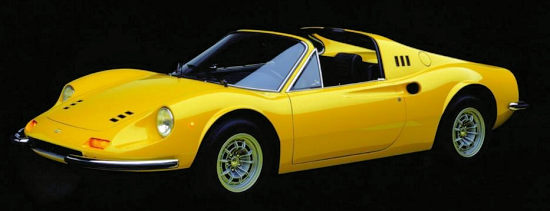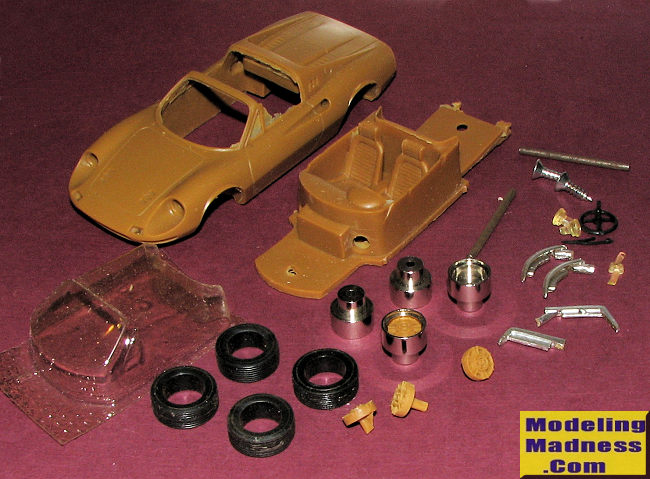Record 1/43
Ferrari Dino 246 GTS
|
KIT #: |
99 |
|
PRICE: |
$20.00 on the second hand market
|
|
DECALS: |
None |
|
REVIEWER: |
Scott
Van Aken |
|
NOTES: |
Multi-media kit in Resin and metal with
vacuform clear bits. |
The Dino 206 GT, 246 GT and 246 GTS are V6 mid-engined sports
cars produced by Ferrari and sold under the Dino marque between 1968 and 1974.
The Dino 246 was the first Ferrari model produced in
high numbers. It is lauded by many for its intrinsic driving qualities and
groundbreaking design. In 2004, Sports Car
International placed the car at number six on its
list of Top Sports Cars of the 1970s. Motor Trend
Classic placed the 206/246 at number seven in their
list of the 10 "Greatest Ferraris of all time".
 Calls for
more power over the 206 GT were answered with the 2.4 L Dino 246. The engine was
a 2418 cc 65-degree, dual-overhead-camshaft, 9.0:1 compression ratio, iron block
with alloy heads. The European motor produced 195 bhp (at 7,600 rpm), and was
available as a fixed-top GT
coupé or, after 1971, an open Spyder GTS.
The American version had an exhaust air-pump, and timing changes which created
175 hp (130 kW). The GT had 3 Weber 40 DCNF/6 or 40 DCNF/7 carburetors. For the
246 a new version of the Dinoplex ignition was deployed, the more compact
Magneti Marelli AEC103A system.
Calls for
more power over the 206 GT were answered with the 2.4 L Dino 246. The engine was
a 2418 cc 65-degree, dual-overhead-camshaft, 9.0:1 compression ratio, iron block
with alloy heads. The European motor produced 195 bhp (at 7,600 rpm), and was
available as a fixed-top GT
coupé or, after 1971, an open Spyder GTS.
The American version had an exhaust air-pump, and timing changes which created
175 hp (130 kW). The GT had 3 Weber 40 DCNF/6 or 40 DCNF/7 carburetors. For the
246 a new version of the Dinoplex ignition was deployed, the more compact
Magneti Marelli AEC103A system.
The 246 Dino GT weighed 2,380 lb (1,080 kg). The 246 Dino GTS
weighed 2,426 lb (1,100 kg). The body was now made of steel to save cost. The
246 Dino had a 2.1-inch (53 mm) longer wheelbase than the 206, at 92.1 inches.
The height of the 246 was the same as the 206 at 43.9 inches.
Dino 246 production numbered 2,295 GTs and 1,274 Spyders, the
latter being built from 1972 to 1974 only, for a total production run of 3,569.
 Typical of the
genere at the time this kit was produced, the parts count is not high and there
are no photo etch bits. The main resin pieces are an upper body with a lower pan
that includes the interior. There is flash over several of the window openings
and some small stubs on the underside to remove. The only part to go into the
interior is a steering wheel. There is a hole drilled for a gear shift lever,
but none was included with the kit. This will be easy enough to duplicate with a
section of straight pin.
Typical of the
genere at the time this kit was produced, the parts count is not high and there
are no photo etch bits. The main resin pieces are an upper body with a lower pan
that includes the interior. There is flash over several of the window openings
and some small stubs on the underside to remove. The only part to go into the
interior is a steering wheel. There is a hole drilled for a gear shift lever,
but none was included with the kit. This will be easy enough to duplicate with a
section of straight pin.
Chromed metal bumpers are included. One of my rear bumpers is
shorter on one side than the other so I'll have to do some trimming during
assembly. Headlights and turn signals are resin castings. Four spun aluminum
wheels are provided with resin inserts for the standard wheels without
knock-offs. A vacuformed piece is provided for the clear bits. Since this is a
targa, the front and rear sections will need to be cut away prior to
installation. Note that the rear window is curved on the outer edges. Two metal
axles are provided along with rubber tires. Each of the wheel assemblies will be
trapped between the upper body and lower chassis/interior pan. A pair of screws
will hold the car together and there is a plastic windscreen wiper included.
The kit provides no instructions and frankly, none are needed.
There are enough images of the car and its various color permutations available
on the 'net to supply the painting info that is needed. About all one could
really ask is for some license plate decals, but again, those can be found with
a bit of sleuthing.
Would this make a nice kit for someone just starting into
multi-media kits? Yes it would. There are enough parts of different materials to
allow one to get involved in the genre without going over their head. The
quality of the parts is very good, and better yet, the resulting model will not
overwhelm one's display area. I've been bulding 1/43 car kits off and on for
many years and have no trouble recommending these. While the companies for many
of these early kits have gone out of business, the kits are not difficult to
find, and for the most part, are not expensive.
https://en.wikipedia.org/wiki/Dino_206_GT_and_246_GT
June 2017
If you would like your product reviewed fairly and
fairly quickly, please
contact
the editor or see other details in the
Note to
Contributors.
Back to the Main Page
Back to the Review
Index Page
Back to the Previews Index Page
 Calls for
more power over the 206 GT were answered with the 2.4 L Dino 246. The engine was
a 2418 cc 65-degree, dual-overhead-camshaft, 9.0:1 compression ratio, iron block
with alloy heads. The European motor produced 195 bhp (at 7,600 rpm), and was
available as a fixed-top GT
coupé or, after 1971, an open Spyder GTS.
The American version had an exhaust air-pump, and timing changes which created
175 hp (130 kW). The GT had 3 Weber 40 DCNF/6 or 40 DCNF/7 carburetors. For the
246 a new version of the Dinoplex ignition was deployed, the more compact
Magneti Marelli AEC103A system.
Calls for
more power over the 206 GT were answered with the 2.4 L Dino 246. The engine was
a 2418 cc 65-degree, dual-overhead-camshaft, 9.0:1 compression ratio, iron block
with alloy heads. The European motor produced 195 bhp (at 7,600 rpm), and was
available as a fixed-top GT
coupé or, after 1971, an open Spyder GTS.
The American version had an exhaust air-pump, and timing changes which created
175 hp (130 kW). The GT had 3 Weber 40 DCNF/6 or 40 DCNF/7 carburetors. For the
246 a new version of the Dinoplex ignition was deployed, the more compact
Magneti Marelli AEC103A system. Typical of the
genere at the time this kit was produced, the parts count is not high and there
are no photo etch bits. The main resin pieces are an upper body with a lower pan
that includes the interior. There is flash over several of the window openings
and some small stubs on the underside to remove. The only part to go into the
interior is a steering wheel. There is a hole drilled for a gear shift lever,
but none was included with the kit. This will be easy enough to duplicate with a
section of straight pin.
Typical of the
genere at the time this kit was produced, the parts count is not high and there
are no photo etch bits. The main resin pieces are an upper body with a lower pan
that includes the interior. There is flash over several of the window openings
and some small stubs on the underside to remove. The only part to go into the
interior is a steering wheel. There is a hole drilled for a gear shift lever,
but none was included with the kit. This will be easy enough to duplicate with a
section of straight pin.